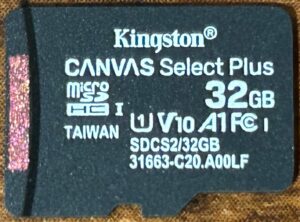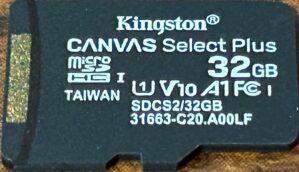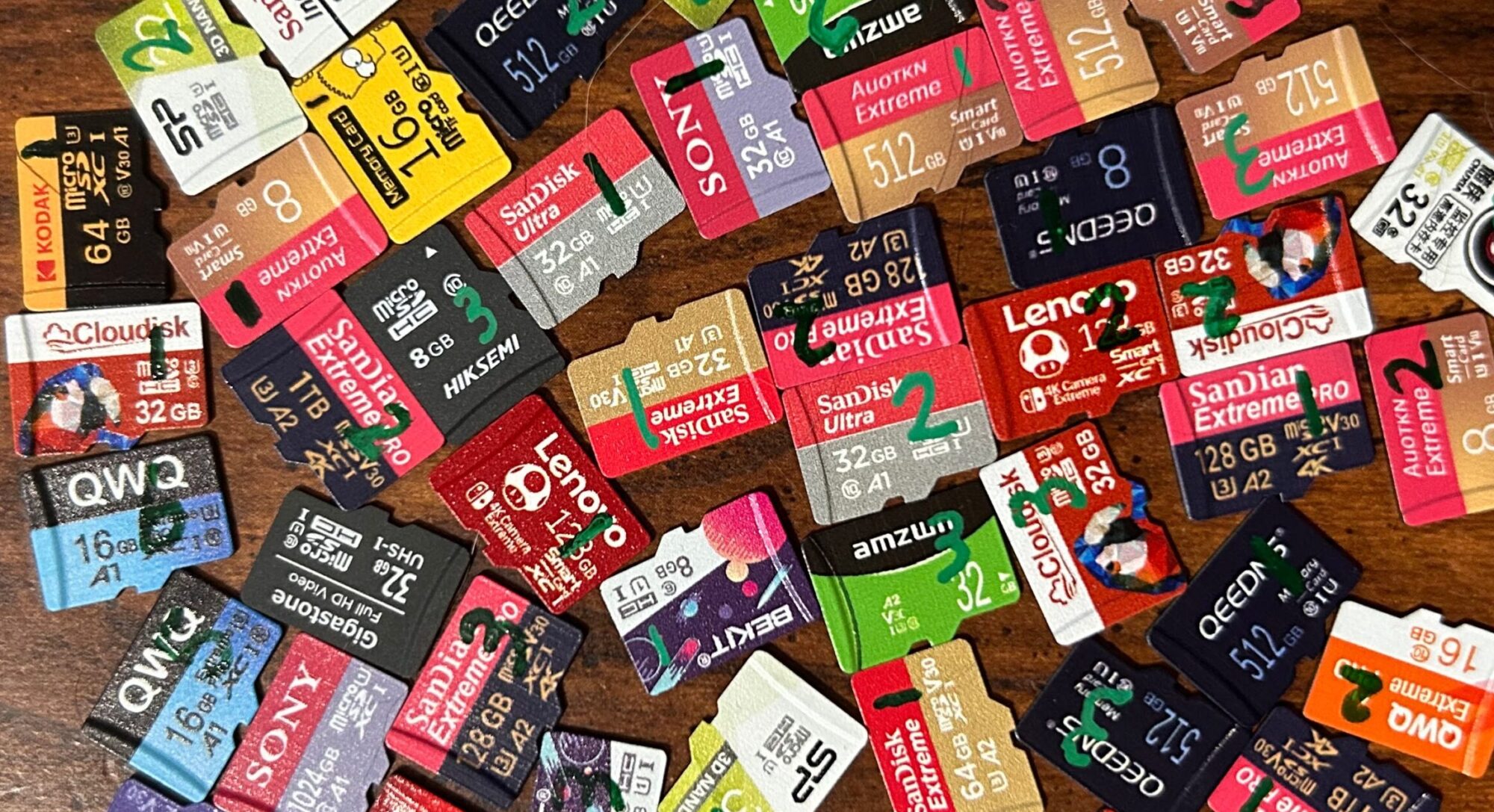Kingston is a brand that I’ve been well aware of for many years now — and going into this project, I’ll admit that I had a bias against them — I’ve had other projects where I’ve used both Kingston and SanDisk cards, and multiple Kingston cards failed on me whereas the SanDisk cards didn’t. Regardless, I wanted to give them a fair chance.
I was curious to see if there would be any difference between the Amazon and AliExpress versions of these cards, so I purchased three of each. Except for the product packaging, the two versions are — as far as I can tell — identical: the CID data is identical (except, of course, for the serial numbers and manufacturing dates), the card markings are identical, and both versions have this interesting color-shifting stripe on the left edge:
 |  |
I know that when Bunnie (of Bunnie Studios) went looking for various Kingston cards in the Chinese markets, he described at least one instance where he saw non-Kingston cards being put into Kingston retail packaging — so I suspect that Kingston did this as sort of a mark of authenticity — something that would be difficult for counterfeiters to duplicate.
As I said above, the primary difference between the two versions seems to be the packaging. And curiously, there’s a notable difference here: the AliExpress version of the packaging is not tamper-evident. The card can be accessed by opening a simple flap on the front of the package; the card can be replaced, and the flap closed, without causing any damage to the packaging. That’s surprising to me — if I were a retailer selling these in a physical storefront, I’d be forced to have them locked up in some fashion to make sure that unscrupulous customers couldn’t just steal these cards.
These cards meet all the criteria that I set out for determining what’s considered a name-brand card, so they’ll go into the name-brand bin in my results.
Performance-wise, these cards actually did rather well. All cards scored above average in all performance metrics:
- One card had a sequential read score that was a little lower than the rest — putting it at the 44th percentile — but the others all scored between the 71st and 78th percentiles (as of the time of this writing).
- Sequential write scores were probably this card’s worst metric, but were still above average. Here, there was a slight difference between the Amazon version and the AliExpress version, with the Amazon version being slightly slower: the Amazon-sourced cards all scored between the 64th and 67th percentiles, while the AliExpress-sourced cards all scored between the 71st and 74th percentiles.
- One card had a random read score that was significantly higher than the rest, putting it at the 98th percentile. (Funnily enough, it was the same card that got the slower sequential read speed that I mentioned above.) The others all scored between the 62nd and 78th percentiles.
- Random read scores all fell between the 76th and 84th percentiles.
These cards carry the U1, V10, and A1 markings. (The Class 10 marking appears on the package, but does not appear on the cards themselves.) All performance measurements were good enough to qualify for all of these markings. (Well done, Kingston!)
On the endurance testing front:
- Sample #1’s first error was an address decoding error during round 480. It has survived 23,696 read/write cycles in total so far.
- Sample #2’s first error was an eight-sector wide address decoding error during round 4,198. It has survived 16,642 read/write cycles in total so far.
- Sample #3 has survived 19,770 read/write cycles and has not yet experienced any errors.
- Sample #4’s first error was an address decoding error during round 2,729. It has survived 21,850 read/write cycles in total so far.
- Sample #5’s first error was an address decoding error during round 127. It has survived 19,612 read/write cycles in total so far.
- Sample #6’s first error was an address decoding error during round 6. It has survived 17,394 read/write cycles in total so far.
So how well have these cards performed overall? Pretty well, actually — they’re decent performers, although they are on the high end for skimp. They’ve done pretty well on my endurance tests as well — they have had occasional issues, but those issues have been few and far between…and the more that this project has gone on, the more I’m realizing that occasional issues are just a fact of life with microSD cards. So I think I’d have to say that if you need a decent middle-of-the-road card, this is a good one to go with.
September 27, 2025 (current number of read/write cycles is updated automatically every hour)

